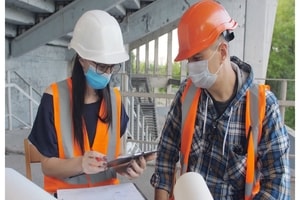3 Trends and Events That May Affect Building Product Specification in 2021
- < How COVID-19 Will Affect Manufacturers & Suppliers Into 2021
- > LEED v4.1 Certification and Building Product Specification
There are several trends and events that may shape building product specification in 2021. These include COVID-19, sustainable design, and new technologies that will alter the AEC landscape. Our team will review these potential game-changers for 2021 and how they may affect building product manufacturers.
COVID-19
One of the greatest threats to the construction industry and economy is COVID-19. The pandemic has had a devastating impact throughout 2020 on the entire AEC community. According to Construction Connect, “from February through April, the construction industry lost over a million jobs. To put that in perspective, during the Great Recession the industry lost about 2.3 million jobs.”
Building product manufacturers are facing significant challenges. In a previous blog, we discussed how the Coronavirus Pandemic has affected product manufacturers and suppliers. Lockdowns have triggered massive job losses not seen since the Great Depression. Jobsites have been shut down across the country during 2020 due to the pandemic.
Building product manufacturers have faced severe obstacles reaching architects, specifiers, designers, and decision makers. Many prominent AEC firms banned face to face lunch and learns and sent many employees home for months. Manufacturers who had robust online learning courses and webinars were able to navigate these challenges. Manufacturers who lacked strong online education programs have been impacted negatively and lost market share.
Moving into 2021, COVID-19 will continue to impact building product manufacturers. Possible impacts could include regional shutdowns or even a federally mandated shutdown. Owners have delayed or cancelled projects further eroding manufacturer revenues and in some cases have caused massive lay-offs. Contract disputes, lawsuits, and ruthless competition is sure to bankrupt some contractors and put intense pressure on manufacturers who fail to adapt to the changing landscape.
The AIA has predicted that that spending on nonresidential building projects is on the decline and will remain so through 2021. Companies are reluctant to invest in projects without knowing there is a COVID-19 vaccine on the horizon that would ease concerns about job sites, work crews, and other factors. Office space and retail construction is expected to plummet in 2021 has more employees are working remote.
Sustainable Design
Another factor that will affect building product manufacturers in 2021 are sustainable design projects. There has been an increasing aggressive specification threshold for LEED projects over the past few years. LEED v4 was launched in 2013 and very few building product manufacturers had EPDs, Declare Labels, and Health Product Declarations (HPDs).
Manufacturers who waited several years to develop the mandatory specification documents for LEED v4 projects started finding themselves shut out of projects, the ability to deliver AIA box lunch presentations, and a general disregard for their products. The landscape has drastically changed over the past two to three years and many manufacturers are playing catch-up.
LEED v4.1 will most likely launch in 2021. A beta version has been running through 2020 and there are many new opportunities for manufacturers. In addition to LEED, there are other green building ratings systems on the rise. WELL v2 was launched this year and continues to gain a foothold in the marketplace, especially in urban areas. The Living Building Challenge is still on the fringes of the marketplace and its doubtful it will be scaled up to the level of LEED or WELL.
Building product manufacturers who develop transparency documentation, train their employees about the emerging ratings systems, and optimize their products will be better prepared for 2021. Manufacturers who continue down the same path and delay these efforts will lose market share and face potential ruin.
Drone Technology
The construction drone industry is estimated to reach $11.96 billion by 2027. The upfront costs of drones has declined significantly over the past few years. Land surveying continues to be the number #1 use for drones on construction sites, providing accurate results in a fraction of the time ground-based methods. Drones are also used to inspect the site and make sure workers are doing their jobs properly.
Drones can help project teams and ultimately manufacturers in many cases be more effective in planning, installing, and maintaining a structure. Safety issues are quickly discovered, quantities of materials on site can be accurately estimated, and maps can be created making even the largest job site visible as a whole. Significant savings can be achieved with drones.
Overall, COVID-19, sustainable design systems, and drone technology will affect building projects, manufacturers, owners, and the AEC industry in 2021.
For more information or to discuss the topic of this blog, please contact Brad Blank





